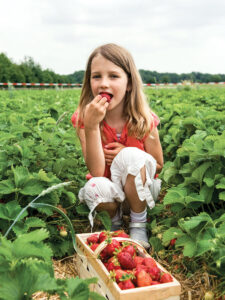 That first bite makes the taste buds tingle from the juicy, ripe, red berries to the tender, slightly-sweet cake and the luscious whipped cream; it’s a tower of heavenly delight! Strawberry shortcake – is there anything better? It’s a great way to kick off grilling season and usher in summer, and there is that feeling of satisfaction when you pick your own berries.
That first bite makes the taste buds tingle from the juicy, ripe, red berries to the tender, slightly-sweet cake and the luscious whipped cream; it’s a tower of heavenly delight! Strawberry shortcake – is there anything better? It’s a great way to kick off grilling season and usher in summer, and there is that feeling of satisfaction when you pick your own berries.
One of my favorite childhood memories was going to a pick-your-own strawberry patch each spring. We would crawl down the straw-covered rows, peeking under those lush green leaves in search of the perfect strawberry. I wanted to find the biggest one I could and quite often would pop one in my mouth while picking. Mmmm, my mouth is already watering! We would pick multiple flats of berries and then head home and have strawberry shortcake and make strawberry freezer jam. I don’t remember the name of the patch where we picked, but the warm breezes and sun shiny experience stays with me. And the flavor of those berries, oh my!
Strawberry picking is a great springtime activity for young and old alike and everyone enjoys being out in the sun on a late spring morning. There are u-pick strawberry farms spread across the state.
One such farm is Big M Berry Patch, outside of Taylorville, which has been in the Repscher family since the mid-1800s. Mel Repscher’s great grandfather, George Parrish, was the village blacksmith in Clarksdale and, at the turn of the century, owned about 1,000 contiguous acres, a lot of land back then. Mel’s grandmother, Lutie Parrish Repscher, was one of four children who each inherited one-quarter of the land, and built the house where Mel and wife Rita still live today. It’s the same house where Mel’s father was born and they use the same antique wrought iron bed.
The Repscher farm raised what Mel refers to as “row crops” of corn and beans, but in the 1980s, when his father retired, the farm economy was so bad that Mel looked to diversify. He contacted the University of Illinois Extension Service and investigated growing everything from sod to walnut trees to berries. In 1985, they put out their first three acres of strawberries.
The first year of picking, the patch would have to be closed about three days per week to wait for the berries to ripen again. So, the following year they put out another two acres of strawberries, and that was just about right.
After the success of the strawberries, they decided to try asparagus. In 1987, they planted two acres of it. Asparagus seems to be one of those vegetables you either love or hate. Mel says, “My dad was one of those that hated asparagus. When I told him what I’d done, he said, ‘My God, boy, there isn’t enough people in Illinois to eat all that!’”
He was proven wro ng and was shocked it was as popular as the strawberries.
ng and was shocked it was as popular as the strawberries.
The farm expanded a bit each year, and is now home to about 20 acres of berries and vegetables. The strawberries are available to pick yourself, call ahead for already picked berries, or can be found at the Taylorville Farmer’s Market, held on Saturdays from late April thru October.
Mel and Rita have four children Matt, Myles, Mike and Michelle, hence the name Big M Berry Patch. All grew up helping on the farm, but today Matt and Myles are the most involved in farming operations. Matt’s children are almost old enough to help as well.
During asparagus and strawberry season, the farm hires as many as 10 high school or college-aged students to help weed and pick. Mel explains, “It’s not an easy job, and we’ve had the occasional worker that hasn’t returned after a day or two of back-breaking work, but they can make good money doing it. They are paid by the pound and can easily make $20 an hour.” After strawberry season, two or three students will stay on to help until they need to return to school.
In February, the Repschers clean out the greenhouse to get early seeds of broccoli, cabbage, cauliflower, peppers and tomatoes started. “We also have to prune blackberries when they begin to break dormancy. With the warm weather this year, it’s likely to be earlier than usual,” notes Matt. “As far as strawberries, we keep a close eye out for any showing of green underneath. They are covered with straw to help keep that from happening, but we will need to rake the straw off and weed them.”
Every year they re-plant about a fifth of the patch, so no plants are more than five years old. The new plants aren’t harvested that year. Mel explained that they want the plants to be vigorous, and if they get too thick, which happens after a few years, it stunts the growth. They have a four-seat planter they can ride on that can put about 15,000 plants a day into the ground. Those planting have to place each strawberry plant into a rubber holder on a wheel which slowly places them in the soil as it goes down the row. It’s a slow process but easier on the backs than walking the rows and placing them by hand.
As with most crops, weather is the biggest challenge to growing strawberries – spring frost, in particular. The Repschers have a solid-state irrigation system with aluminum pipes and sprinkler heads. They keep a close eye on the weather forecast and on the nights when frost is expected, Mel sleeps in an old van out at the berry patch. He closely monitors the temperature and if it drops to below 33 degrees, usually around 2 a.m., he starts the irrigation system.
“We’ve got over a mile of irrigation pipe. I have to walk in the dark with a flashlight and the sprinklers blowing on me, checking to make sure no sprinkler heads are clogged with a seed or a possible spider’s web,” Mel explains. “When that happens, then I’m down there with my face in the water trying to unplug it.”
When frost is predicted in the spring, it usually occurs two or three nights in a row. Mel says that it can get very old, and by the third night he is worn out, but it’s necessary. He explained that he must keep the surface of the ice wet on the plants. The freezing process generates just a fraction of a degree of temperature and, even though there’s ice on the leaves, beneath the ice the temperature will be around 32.3 degrees, just enough to keep it above freezing. If he were to shut off the irrigation, the evaporative cooling would drop that temperature. The irrigation system puts out 350 gallons a minute – about 27,000
gallons an hour.
“Once you start it, you’ve got to keep it going until it warms up, usually around 7:30 or 8 a.m.,” he says. “There’s a film of water between the leaves and the ice, and once it warms up, you can actually just slip the ice off the leaves.”
Big M Berry Patch has six or seven different varieties any given year that vary in berry size, length and maturity. Though they all break dormancy at the same time, one of their customer’s favorites is the Early Glow, which matures a week or two earlier than the others. Over the years, the Repschers have tried about 15 different varieties, but Early Glow is the oldest and most popular variety. Customers will even ask for them by name.
Berry season only lasts three to four weeks, beginning around Memorial Day. At daybreak, pickers need to be out in the fields to harvest enough berries before the farmer’s market opens at 9 a.m. It’s not unusual for the Repschers to take 250 quarts of berries in town and be sold out within an hour. They usually have pickers still working the fields and making trips into the market with the newly picked berries and seasonal vegetables.
“It’s a balancing act,” notes Mel. “We don’t want to have any strawberries left at the market, but we want to try to satisfy all of the customers that want them. If we sell out, we can tell them that in 45 minutes we’ll have another 50 quarts. We can move through 400-500 quarts on a Saturday.”
A couple of the Repschers man the booth at the farmer’s market while others continue to pick and/or handle the u-pick patch. After customers that want to pick their own are done, the pickers go over those rows to remove any bad berries. It helps the berries last a bit longer.
Once strawberry season is over, the work doesn’t end. That’s when renovation starts, a process that involves spraying herbicide to kill weeds. Once it takes effect, they mow off the plants just above the ground and till in between the rows to get the straw worked into the soil. On observation, it looks like they’ve destroyed the patch, but after watering them for about a week, new buds emerge. Within a month’s time of watering they have new lush, green plants, which are dormant the rest of summer.
In the fall, rows are cut back and plants are thinned out to about every six inches. They blow wheat or oat straw on them around the first of December after two or three nights of hard freeze. And, the cycle starts all over again.
If you have never experienced picking your own strawberries, I highly recommend it. It’s an educational time for kids to learn about how their food is grown, and great memories can happen.
Take a look at the map to see if there is a patch in your area, or go to www.pickyourown.org or www.agr.state.il.us/wherefreshis/ to find one close by.

U-Pick Berry Patches
- Big M Berry Patch, Taylorville, 217-824-6625, strawberries, black raspberries, blackberries;
www.facebook.com/bigmberrypatch?rf=121162824602661 - Moran’s Orchard, Trilla, 217-895-3408;
www.facebook.com/Morans-Orchard-221164274662221/ - Buxton’s Garden Farm, Sullivan, 217-728-7993; www.facebook.com/buxtonsgarden/
- Boone’s Knob Berry Farm, Barry, 217-656-3923; www.facebook.com/Boones-Knob-Berry-Farm/
- Johnston’s Berries, Shelbyville, 217-774-3762; www.facebook.com/johnstons.berries?fref-ts
- Just Berries, Stewardson, 217-682-5588, strawberries, blueberries, blackberries;
https://www.facebook.com/Just-Berries-182337651804650/ - Plow Creek Farm, Tiskilwa, 815-646-9126; http://www.plowcreek.org/farm/
- Jefferies Orchard, Springfield, 217-487-7582, strawberries and blueberries; www.jefferies-orchard.com
- McLaughlin Strawberry Farm, Murphysboro, 618-684-4034; @aol.com
- Blueberry Hill Farm, Cobden, 618-893-2397; blackberries, blueberries, raspberries, strawberries; ://www.facebook.com/pages/Blueberry-Hill-Frm/145088728847265
- Greer’s Lost Creek Farm, Carbondale, 618-457-5949, blueberries only,
https://www.facebook.com/pages/Greers-Lost-Creek- Blueberries/482903965119687 - G & C Meyer Farm, Steeleville, 618-965-3800, blackberries, blueberries, red and black raspberries only
- Miller Farms, Campbell Hill, 618-426-1094, strawberries and blueberries
- Hallsberry Farms, Buncombe, 618-559-6127; https://www.facebook.com/Hallsberry-Farms-607311662746573/










